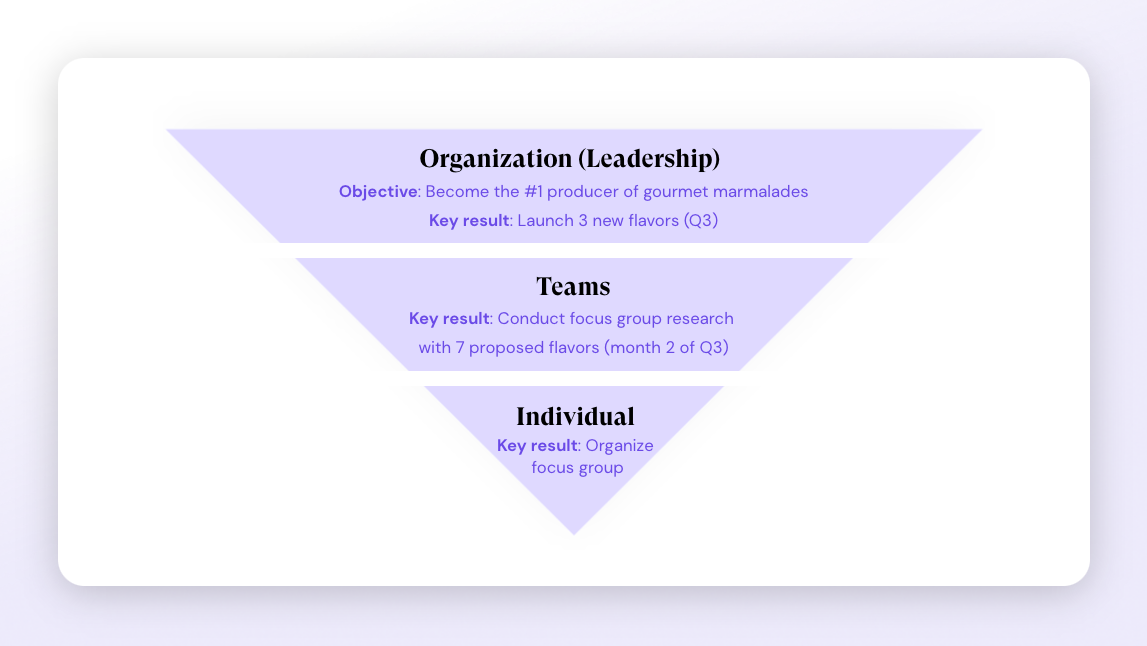
TL;DR: Setting team goals is a best practice to ensure that your company’s vision translates to all levels and that employees know how their work supports it. Choosing and pursuing the right team goals will improve alignment, engagement, accountability, and performance. We recommend setting team goals by following the OKR methodology.
Focusing on the right goals and working as a unit is the best way for an organization to thrive and achieve its mission. But achieving optimal alignment demands having clarity on company-level objectives and committing to team goals — elements of a company’s overarching objective that different teams must pursue.
But setting goals doesn’t just benefit the organization. People have a great need for finding meaning at work. A crucial path to achieve that is to understand how one’s contributions drive the growth of a company and its mission forward. And team goals are a surefire way to show the impact of a team’s accomplishments on company growth. Not to mention the fun of bringing different skill sets together and working on solutions as a team!
The Objectives and Key Results methodology (OKRs) is ideal for enabling team goals and setting employees up for success and fulfillment. The concept, adopted by corporations like Google, thriving small and medium-sized businesses, and fast-growing startups alike, is quite simple and effective. OKRs communicate a formula: We will make progress in pursuit of [OBJECTIVE] by achieving [KEY RESULTS].
As we shared in our step-by-step playbook on how to implement OKRs (which we highly recommend you read):
Objectives must be bold, concise, and straightforward, expressing the company’s vision. Key Results define how you’ll reach goals and track progress — so they must be measurable. A best practice is to work with quarterly OKR cycles.
Objectives represent a company’s vision, and key results are pieces of the bigger picture. And to achieve the best results with OKRs (with more alignment and employee engagement to boot), we recommend setting them up each quarter. You should also follow the cascading goal methodology — another simple yet ingenious concept.
In short, goal cascading is the process of structuring goals throughout all company levels:

Cascading goals support transparency, alignment, accountability, and business growth. Think of it like a rowing team: all team members are essential, and they must be perfectly synchronized to achieve success. And a misaligned team member — even a hardworking one — could make the boat capsize.
Elon Musk once shared his thoughts on this topic, presenting the idea of each employee being a “vector”: maximum business impact requires that everyone moves in the same direction. But if some “vectors” move in other directions, impact is null.
When the efforts of each individual, team, and department align with the organization’s top-level goals, we ensure that we’re moving according to the plan, towards the direction of our final destination or goals. Aligned efforts build on top of each other to make sure we reach our goals.
Knowing what team goals are and why they’re so important, it’s time to set them up. In this playbook, we’ll tell you all you need to know.
.png)
We recommend this playbook to C-level executives, HR/People Ops professionals, managers, and individual contributors looking to achieve more alignment and results, and nurture team engagement and morale.
What’s the mission of your business? Where would you like to be within the next three to five years? This should be clear to you — but if it’s not, we’ve got just the resources you need to gain clarity.
As team goals should enable the organization to achieve goals, we recommend that you have these in mind while working on goals for your team.
With the company-wide goals in mind, consider how your team can contribute to them.
The department’s manager may work on a rough draft on their own, but it’s a best practice to finish creating team goals with contributions from all team members.
At this stage, aim to have a longer list of ways your team could support top-level objectives. Although your initiatives should be quantifiable, this isn’t yet the time to set a number.
Schedule a brainstorming session with your team to define objectives to support the business goals. The OKR methodology recommends 3 to 5 objectives per quarter.
Learn all about setting the right objectives and key results here.
Remember: Objectives are what you want to achieve, and key results are the milestones you’ll pass on the way there.
Suppose one of your objectives, as the marketing team of Mars Marmalades in Q2, is to grow brand awareness in specific markets. In that case, key results could involve:
Check out this example of company goals (also at Mars Marmalades) for a different quarter and contributions (key results) from various teams:
.png)
See what a few of the great departments at Mars Marmalades are planning as key results for Q3 to support the company-wide goals:
Food Engineering
Industrial Engineering
Marketing
Sales
Each team member should be responsible for ensuring specific key results are reached. Team goals are all about showing employees that what they do matters, so give them the space to pitch initiatives and share which ones they would want to take ownership for.
You can support your reports in many ways. Give them the resources they need to complete their tasks and offer help throughout the quarter. In some cases, you may also choose to create an action plan with individual contributors.
Having a recurrent OKR check-in meeting is a best practice for “crushing” your department’s OKRs (and yes, we also have step-by-step instructions for that!). And the best way to keep track of progress is to use a holistic people enablement and alignment platform with advanced OKR software like Leapsome.
Besides running OKR check-in meetings and transparently tracking progress with a tool for goals and OKRs, discuss the progress of individual initiatives in 1:1 meetings and provide regular feedback.
💡 Would you like to know more about achieving company and team goals? Download the ultimate guide to OKRs. 😉
Leapsome is the only platform that closes the loop between performance management, employee engagement, and learning.
A goal tree can help you define cascading goals that align with your company’s objectives. Watch this video to learn more about Leapsome’s Goal Tree feature and how it can help you visualize and structure goals within your organization.

Although you might explore the same organizational goals for longer, we recommend quarterly team-wide and individual goals. The reason quarters are an excellent match for goals and OKRs is that a 13-week timeframe allows you to aim for 10% progress each week, with a handy 2-3 week grace period to get going and adjust your route.
If necessary, yes. The goal-setting process should be thorough enough to only be changed if new information becomes available or circumstances change. Yet, reevaluating objectives and key results during a goal cycle has nothing to do with failure.
If a set of key results proves to be unrealistic, you may have to dial back. Or, if a team goal cycle has just begun and your team is already about to reach 100%, you might want to take your key results a step (or two) further.
Learn how Leapsome can automate, connect, and simplify your HR processes.
.webp)
.webp)
 Book your demo
Book your demo


Run smooth operations with our easy-to-follow how-tos and best practices for all things People Ops
Mit unseren leicht verständlichen Anleitungen und Best Practices für People Ops sorgen Sie für reibungslose Abläufe.